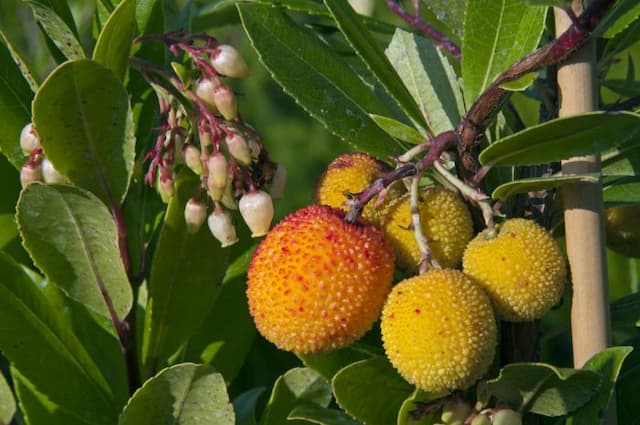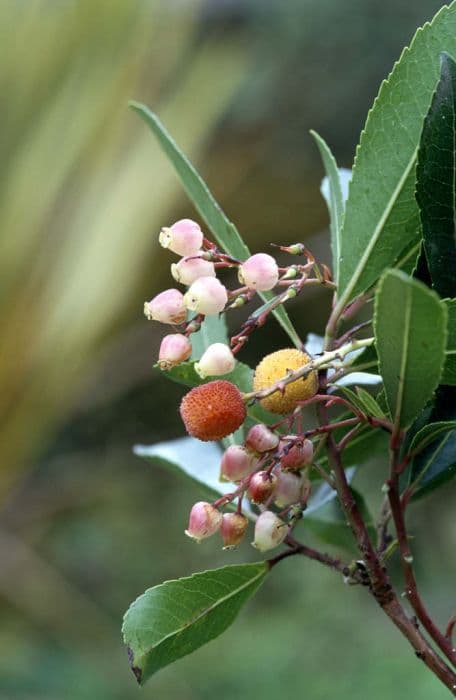Rainbow Leucothoe Leucothoe Lovita = 'Zebonard'

ABOUT
Leucothoe Lovita, commonly known as Dog Hobble, is a striking ornamental shrub that is cherished for its distinctively appealing foliage and flowers. This particular cultivar is known for its vibrant, glossy leaves that boast a mesmerizing kaleidoscope of colors. Throughout the growing season, the foliage transitions through a range of hues, including deep green, mottled pink, cream, and red. As the seasons change, the leaves can deepen in color, adding a warm, rich visual to the garden. Dog Hobble produces dainty, bell-shaped, white flowers that hang elegantly in small clusters along the arching branches. These blossoms have a delicate, enticing fragrance and are a beautiful contrast against the multicolored leaves. The plant has a gracefully arching habit, making it an excellent choice for adding a sense of movement and flow to the landscape. Its branches bear the leaves and flowers densely, giving the shrub a lush, full appearance. The overall visual effect of Dog Hobble is of a richly textured shrub that provides robust color and delicate floral beauty. It can serve as a stunning focal point in shaded garden areas, helping to brighten the space and add year-round interest, without any reference to its specific size or dimension in quantitative measures.
About this plant
 Names
NamesFamily
Ericaceae.
Synonyms
Drooping Leucothoe, Dog Hobble, Fetter-bush, Switch Ivy.
Common names
Leucothoe Lovita 'Zebonard'.
 Toxicity
ToxicityTo humans
The Leucothoe Lovita, also known as 'Zebonard', belongs to a genus where several species are known to contain toxic substances. While specific toxicity information about Leucothoe 'Zebonard' may not be readily available, members of the Leucothoe genus can be poisonous if ingested. They contain grayanotoxins which can cause symptoms such as vomiting, diarrhea, abdominal pain, and in severe cases, respiratory problems, lethargy, and lowered blood pressure. It is advised to avoid ingesting any part of the plant and to seek medical attention if poisoning is suspected.
To pets
The Leucothoe Lovita, commonly referred to as 'Zebonard', is toxic to pets if ingested, similar to its toxicity to humans. It contains compounds that can cause symptoms in pets such as vomiting, diarrhea, drooling, weakness, and in severe cases, seizures, coma, or even death. It is particularly dangerous for cats and dogs, and any suspected ingestion of the plant should be treated as an emergency, with immediate veterinary care sought. Owners should prevent pets from having access to this plant to avoid the risk of poisoning.
 Characteristics
CharacteristicsLife cycle
Perennials
Foliage type
Evergreen
Color of leaves
Mixed
Height
1-2 feet (30-60 cm)
Spread
1-3 feet (30-90 cm)
Plant type
Shrub
Hardiness zones
5
Native area
North America
Benefits
 General Benefits
General Benefits- Ornamental appeal: The Leucothoe Lovita boasts attractive foliage that changes color with the seasons, adding visual interest to garden spaces.
- Shade tolerance: This plant is well-suited for shaded areas where many other plants might not thrive, making it versatile for different garden spots.
- Soil adaptability: Leucothoe Lovita can adapt to a range of soil types, although it prefers acidic, well-drained soils, which makes it relatively easy to incorporate into various landscapes.
- Low maintenance: The plant generally requires minimal care once established, making it a good choice for gardeners of all skill levels.
- Disease resistance: It is resistant to many common plant diseases, thus reducing the need for chemical treatments and contributing to a healthier garden ecosystem.
- Wildlife attraction: The plant can attract birds and other wildlife, which can help with pollination and add another layer of life to a garden area.
- Year-round interest: With evergreen leaves that provide color and texture throughout the year, the Leucothoe Lovita ensures the garden remains vibrant even in colder months.
 Medical Properties
Medical PropertiesThis plant is not used for medical purposes.
 Air-purifying Qualities
Air-purifying QualitiesThis plant is not specifically known for air purifying qualities.
 Other Uses
Other Uses- As a natural dye: The foliage of Leucothoe Lovita can be used in the production of natural dyes for textiles, yielding subtle hues that are well-suited for artisanal crafting.
- Floral arrangements: The stems and leaves of Leucothoe Lovita can be incorporated into floral displays, where they provide a lush, green backdrop to more colorful blooms.
- Garden sculpting: This plant's dense growth habit makes it suitable for topiary or garden sculpting, allowing gardeners to create defined shapes and structures.
- Bee and butterfly garden: Leucothoe Lovita can be integrated into gardens designed to attract pollinators, as its flowers are a source of nectar for bees and butterflies.
- Pond-edge planting: The plant can be used around garden ponds to create a naturalized look, as it thrives in moist conditions and can help stabilize pond edges.
- Theme gardens: Leucothoe Lovita's unique foliage color makes it suitable for themed gardens, such as a silver or blue foliage garden, contributing to a monochromatic aesthetic.
- Pine needle mulch alternative: The fallen leaves of Leucothoe Lovita can be gathered and used as mulch, serving as an alternative to more common pine needle mulch and providing soil enrichment.
- Artistic inspiration: Artists may use the plant as a subject or as a backdrop in their landscape paintings or nature photography, capturing the unique beauty of its foliage.
- Living fence: When planted in rows, Leucothoe Lovita can form a living fence, providing privacy and wind protection in residential gardens.
- Educational tool: Horticulture educators may use Leucothoe Lovita as a specimen to teach about Ericaceae plant family characteristics, acid soil requirements, and landscape uses.
Interesting Facts
 Feng Shui
Feng ShuiThe plant Leucothoe is not used in Feng Shui practice.
 Zodiac Sign Compitability
Zodiac Sign CompitabilityThe plant Leucothoe is not used in astrology practice.
 Plant Symbolism
Plant SymbolismUnfortunately, there appears to be no widely-recognized symbolic meaning for Leucothoe Lovita specifically. As a specialized cultivar, it may not carry the same traditional or cultural connotations as more commonly known plant species and varieties. If Leucothoe as a genus has any symbolic meanings, they are not well-documented or standardized in the way that more prominent plants like roses and lilies are. The symbolic meanings of plants are often derived from folklore, cultural practices, or historical use, and it seems that Leucothoe Lovita 'Zebonard' does not have a well-established place in such traditions.
 Water
WaterTo maintain optimal health for Leucothoe 'Lovita', it should be watered regularly to keep the soil consistently moist but not waterlogged. During the growing season, watering once a week with approximately one gallon of water per plant should be sufficient, depending on climate and soil conditions. If rainfall is abundant, adjust the watering accordingly. During winter, reduce watering but do not allow the soil to completely dry out. It's essential to provide enough water to saturate the root zone each time you water.
 Light
LightRainbow Fetterbush, the common name for Leucothoe 'Lovita', thrives in partial to full shade. It's best to position the plant in a location that receives filtered sunlight or indirect light to protect it from harsh afternoon sun. A spot under the canopy of larger trees or on the north side of a building is ideal to provide the necessary light conditions for this plant.
 Temperature
TemperatureThe Rainbow Fetterbush prefers a temperature range that is generally moderate. It can withstand a minimum temperature of around 0 degrees Fahrenheit and a maximum of 80 degrees Fahrenheit, but its ideal temperature conditions are between 50 and 70 degrees Fahrenheit. Ensure the plant is protected from extreme cold by mulching around the base in colder regions.
 Pruning
PruningPruning the Rainbow Fetterbush is primarily done to maintain its shape and remove any damaged or diseased branches. Pruning should be performed in late winter or early spring before new growth begins. It's sufficient to prune the plant every year or every other year, focusing on thinning out overcrowded areas to allow light and air circulation, which helps prevent disease.
 Cleaning
CleaningAs needed
 Soil
SoilThe best soil mix for the Drooping Leucothoe or 'Zebonard' should be rich, well-draining, and slightly acidic, with a pH around 4.5 to 6.0. An ideal mix can be created by combining peat moss with pine bark and perlite or sand to enhance drainage.
 Repotting
RepottingDrooping Leucothoe, commonly known as 'Zebonard,' should typically be repotted every 2 to 3 years or when it outgrows its current pot. Repotting should be done in early spring before new growth begins.
 Humidity & Misting
Humidity & MistingDrooping Leucothoe thrives best in moderate to high humidity levels, around 50-60%. Providing a humid environment mimics its natural habitat and contributes to its health and growth.
 Suitable locations
Suitable locationsIndoor
Ensure acidic soil, bright indirect light, and moist conditions.
Outdoor
Plant in partial shade, acidic soil, and protect from harsh sun.
Hardiness zone
5-8 USDA
 Life cycle
Life cycleThe Leucothoe fontanesiana 'Lovita', typically known as Drooping Leucothoe or Dog Hobble, begins its life cycle with seed germination, where environmental conditions such as light, temperature, and moisture trigger the growth of the seed. After germination, the seedling emerges and establishes roots in the soil, followed by the development of leaves during the juvenile phase. As the plant matures, it enters a vegetative stage, growing larger and producing more foliage, and in favorable conditions, it will develop small, bell-shaped, white or pinkish flowers in spring. After pollination, typically by insects, the flowers produce berries that mature in late summer to autumn, turning reddish-black when ripe. These berries can then be dispersed, often by birds or small mammals, allowing for new plants to potentially grow in a new location. Finally, the plant enters a period of dormancy during colder months, to begin the cycle anew with the return of warmer seasons.
 Propogation
PropogationPropogation time
Spring-Early Summer
Leucothoe Lovita, also known as Dog Hobble 'Zebonard', is typically propagated by semi-hardwood cuttings. The best time for taking cuttings is during the late summer when the new growth has started to mature and harden slightly. To propagate, a cutting approximately 4 to 6 inches (10 to 15 cm) long is taken, with the lower leaves removed to expose a few nodes. These cuttings are then dipped in rooting hormone to encourage root development and planted in a well-draining potting mix. A plastic bag or a propagation dome can be placed over the container to maintain high humidity levels. The cuttings should be kept in bright, indirect light and away from direct sunlight to prevent scorching. With consistent moisture and warmth, roots will usually begin to form within several weeks.









